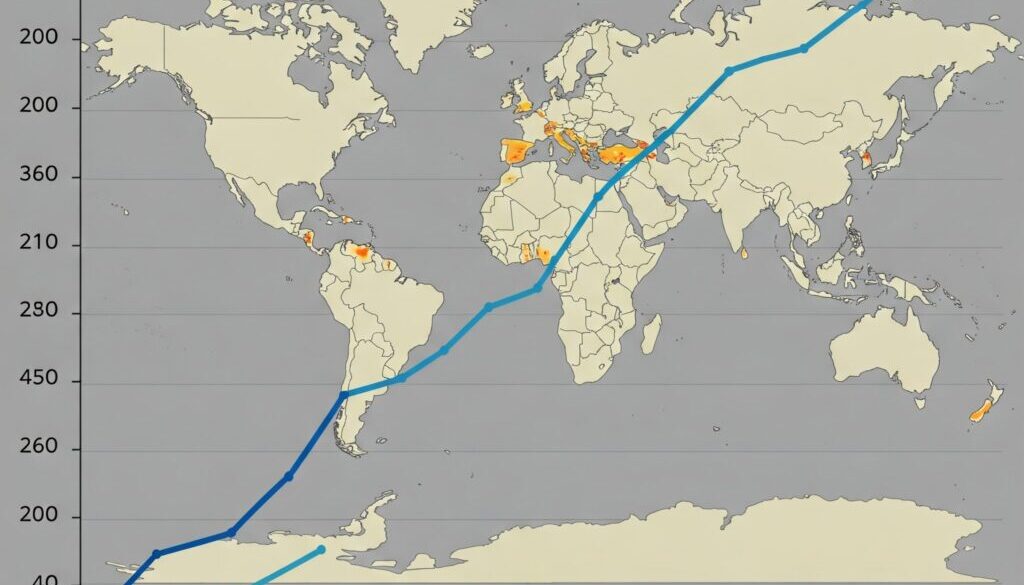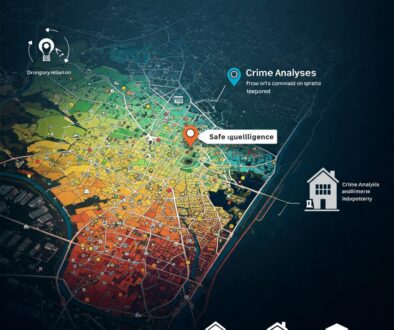The Hidden Costs of Poor Location Intelligence in Real Estate Investment
For real estate investors, the true cost of a property extends far beyond the initial purchase price. While most investors carefully analyze the obvious expenses like acquisition costs, renovation budgets, and financing terms, many significantly underestimate the long-term financial impact of inadequate location intelligence.
In 2025’s competitive market, sophisticated investors are leveraging advanced geospatial intelligence platforms like Locas.dev to uncover hidden location-based costs and risks that traditional analysis often misses. This comprehensive approach not only prevents costly surprises but also identifies value opportunities that others overlook.
The Financial Impact of Location Intelligence Gaps
Poor location intelligence can impact your investment in multiple ways:
1. Direct Financial Costs
- Insurance premium surprises due to unidentified risks
- Unexpected infrastructure contributions required by municipalities
- Environmental remediation expenses for undetected issues
- Higher-than-projected vacancy rates in challenging locations
- Extended marketing periods for properties with undiscovered drawbacks
2. Opportunity Costs
- Missed appreciation potential in emerging neighborhoods
- Lower rental premiums due to unrecognized location advantages
- Tenant quality limitations from neighborhood misconceptions
- Reduced development potential from overlooked zoning opportunities
- Financing disadvantages compared to better-analyzed properties
3. Long-term Strategic Costs
- Portfolio imbalance from location correlation blindspots
- Exit strategy limitations due to unforeseen location challenges
- Brand damage from problematic investments
- Capital allocation inefficiency from misunderstood location value
- Competitive disadvantage against better-informed investors
Seven Hidden Location Costs That Erode Investment Returns
1. Unidentified Environmental Liabilities
The Problem:
Traditional location analysis often fails to identify subtle environmental issues that can create significant financial liabilities, from soil contamination to air quality problems.
The Real Cost:
“A seemingly perfect industrial conversion project turned into a nightmare when we discovered soil contamination from a business that operated on the site in the 1970s,” explains Robert Tanaka of Urban Conversion Group. “The remediation cost $1.2 million and delayed our project by 11 months—expenses that proper location intelligence would have identified before purchase.”
The Intelligence Solution:
Advanced geospatial platforms analyze historical land use, environmental monitoring data, and sophisticated risk models to identify potential environmental issues before they become expensive surprises.
2. Misunderstood Flood and Climate Risks
The Problem:
Standard flood zone maps and basic climate risk assessments fail to capture the nuanced and evolving nature of these risks, especially as climate change accelerates.
The Real Cost:
A 2024 study by the Urban Land Institute found that properties with unidentified flood risks experienced:
- 27% higher insurance premium increases over five years
- 38% more frequent uninsurable damage events
- 42% higher maintenance costs related to water issues
- 19% lower appreciation rates compared to market averages
The Intelligence Solution:
AI-powered climate risk models incorporate micro-topographical analysis, infrastructure vulnerability assessment, and forward-looking climate projections to quantify actual risk exposure and potential mitigation strategies.
3. Infrastructure Dependency Blindspots
The Problem:
Many properties rely on aging infrastructure whose failure or required replacement can create unexpected costs for property owners through assessments, reduced functionality, or value impairment.
The Real Cost:
“We purchased a well-priced commercial property only to discover that the municipal water infrastructure serving the area was at capacity,” notes Maria Sanchez of Cornerstone Investments. “When we wanted to expand, we faced a $430,000 infrastructure contribution requirement that significantly impacted our project’s viability.”
The Intelligence Solution:
Comprehensive location intelligence includes infrastructure age analysis, capacity evaluation, planned improvement research, and assessment risk modeling to identify potential infrastructure-related costs before they surface.
4. Regulatory Evolution Exposure
The Problem:
Zoning, permitting, and regulatory environments constantly evolve, sometimes creating significant costs or limitations for property owners who fail to anticipate these changes.
The Real Cost:
A multi-family investor in Seattle saw their renovation return model collapse when new tenant protection regulations were enacted shortly after their acquisition. The regulations, which had been under discussion for months, created $3,200 per unit in additional costs and compliance requirements.
The Intelligence Solution:
Modern location intelligence platforms track regulatory discussions, policy patterns, and enforcement trends to predict how the regulatory landscape might change and how those changes could affect specific properties.
5. Demographic Shift Misalignment
The Problem:
Many investment strategies rely on assumptions about an area’s demographic profile that prove incorrect or fail to account for rapid demographic changes.
The Real Cost:
“We developed a luxury residential project based on demographic data that showed high incomes in the area,” explains Thomas Rodriguez of Summit Development. “What the data missed was that those high-income residents were primarily retirees who had no interest in our product. We faced 18 months of carrying costs before repositioning the development for a different market.”
The Intelligence Solution:
Advanced demographic analysis includes not just current profiles but predictive modeling of demographic evolution, migration patterns, and lifestyle preference mapping to anticipate who will want to live in an area in the future.
6. Access and Connectivity Misconceptions
The Problem:
Simple measures like distance to transit or major roads fail to capture the true accessibility and connectivity of a location, leading to flawed assumptions about convenience and appeal.
The Real Cost:
A retail developer selected a site that appeared ideally located near a highway interchange, only to discover after purchase that the traffic pattern created significant “side friction” that made entering the property difficult. This access challenge reduced customer traffic by an estimated 22% compared to projections, dramatically affecting tenant performance and retention.
The Intelligence Solution:
Modern geospatial platforms analyze actual travel patterns, access friction points, connectivity quality, and multi-modal transportation options to provide a realistic view of a property’s true accessibility.
7. Amenity Evolution Blindness
The Problem:
The amenity landscape around a property isn’t static, yet many investment decisions treat it as such, missing both threats (amenity closures) and opportunities (new amenity development).
The Real Cost:
An apartment investor acquired a property based partly on its proximity to a popular grocery store and retail center. When that anchor tenant closed six months later, occupancy dropped by 7% and rents stagnated despite a strong overall market, creating a significant performance gap.
The Intelligence Solution:
Sophisticated location intelligence tracks business health indicators, lease expiration timing, ownership stability, and development patterns to forecast how the amenity environment around a property might evolve.
The Quantifiable Impact: Location Intelligence ROI
The financial impact of comprehensive location intelligence can be substantial:
Mountain View Terrace Case Study
A multi-family investor was considering a $14.2 million acquisition in a transitional neighborhood. Traditional analysis suggested the investment met their criteria, but geospatial intelligence revealed several critical factors:
- Environmental Analysis: A 76% probability of soil contamination requiring remediation based on historical use patterns
- Infrastructure Assessment: Water system serving the property was at 94% of capacity with $1.1M in upgrades planned within 5 years
- Regulatory Evolution: High likelihood of inclusionary housing requirements increasing based on policy patterns
- Demographic Projections: Area demonstrated early-stage gentrification metrics but with a 7-10 year horizon rather than the 3-5 years assumed
Based on this intelligence, the investor negotiated a $1.85 million price reduction and structured a phased development approach aligned with the actual demographic evolution timeline. The adjusted strategy is projected to deliver a 27% higher IRR than the original plan.
Implementing Comprehensive Location Intelligence
To avoid the hidden costs of location intelligence gaps:
1. Adopt a Multi-Layered Approach
Move beyond basic location metrics to a comprehensive evaluation incorporating:
- Environmental risk assessment
- Infrastructure dependency analysis
- Regulatory trajectory modeling
- Demographic evolution forecasting
- Accessibility quality measurement
- Amenity stability evaluation
- Climate vulnerability prediction
2. Incorporate Intelligence Early in the Process
Rather than using location intelligence as a final verification tool, integrate it into your initial screening process to avoid wasting time on properties with fundamental location challenges.
3. Quantify Location Risks and Opportunities
Translate location intelligence insights into specific financial projections by:
- Building risk costs into underwriting models
- Creating multiple scenarios based on different location outcomes
- Assigning probability-weighted costs to potential location challenges
- Identifying value-add opportunities based on location advantages that others miss
- Including location-specific contingencies in purchase agreements
- Developing mitigation strategies for identified location risk
4. Monitor Location Evolution After Acquisition
Location intelligence isn’t just for acquisition decisions—it should inform your ongoing ownership strategy:
- Track predicted vs. actual location changes
- Identify emerging opportunities or threats
- Time improvement investments to align with neighborhood evolution
- Adjust marketing strategies based on changing location perceptions
- Optimize exit timing based on location trend analysis
5. Build Location Intelligence Into Your Competitive Advantage
The most sophisticated investors don’t just use location intelligence defensively to avoid problems—they leverage it as an offensive strategy:
- Identify locations with positive change indicators before they’re widely recognized
- Recognize location-based value that others consistently misjudge
- Develop specialized expertise in specific location types or transformation patterns
- Create standardized location intelligence frameworks that can be applied systematically
- Build proprietary datasets that enhance publicly available location information
The Evolution of Location Intelligence: What’s Next
As location intelligence technology continues to advance, several emerging capabilities promise to further reduce hidden costs and identify new opportunities:
Real-time Monitoring
Future platforms will provide continuous monitoring of location factors, alerting investors to changes that might impact property performance:
- Infrastructure failure warnings
- Regulatory proposal notifications
- Business closure or opening alerts
- Crime pattern shift identification
- Development activity notifications
Predictive Intervention Modeling
Advanced systems will not only identify potential location-based costs but suggest specific interventions to mitigate them:
- Environmental remediation approach recommendations
- Infrastructure investment strategies
- Regulatory compliance pathways
- Community engagement opportunities
- Risk reduction techniques with ROI analysis
Opportunity Matching
The next generation of location intelligence will actively match investors with locations that align specifically with their strategy, expertise, and risk tolerance:
- Strategy-specific location recommendations
- Comparative opportunity analysis
- Portfolio diversification suggestions
- Location trend alignment with investment timeline
- Competitor blind spot identification
Conclusion: From Hidden Costs to Strategic Advantage
The hidden costs of poor location intelligence can significantly erode real estate investment returns, but the solution goes beyond simply avoiding these pitfalls. Comprehensive location intelligence offers a pathway to strategic advantage in an increasingly competitive market:
- Cost avoidance through early identification of location-based risks
- Value discovery by recognizing location advantages others miss
- Strategic timing of acquisitions, improvements, and dispositions
- Operational optimization based on location-specific opportunities
- Portfolio balance through sophisticated location correlation analysis
As real estate markets become more efficient, the information asymmetry provided by superior location intelligence remains one of the few sustainable competitive advantages available to investors.
Ready to transform location intelligence from a hidden cost to a strategic advantage in your real estate investments? Try Locas.dev today and discover what comprehensive geospatial analysis can reveal about your target properties.
This article reflects the current understanding of location intelligence impact on real estate investment. For the latest updates and features, visit Locas.dev.
Keywords: location intelligence real estate, property investment risks, hidden real estate costs, geospatial analysis ROI, location due diligence, investment risk assessment, property location analysis



